
October 16, 1943 – Crowd at State and Madison waiting in line to buy a ticket on the opening of Chicago’s new subway.
This is part three in our ongoing series on Chicago’s first subways, the first of which opened 70 years ago this year.

January 10, 1939 – CHICAGO, ILL. – Chicago’s dream is fast becoming a reality as workmen continued to drill the preliminary tunnel toward the route of the main subway tube in the middle of State street. With about 250 feet yet to go to that objective, machinery and material are being fed through this preliminary arterial which will provide an outlet for excavated earth. Photo shows a car loaded with clay as it is being pushed along the tracks by workers as progress is being made on Chicago’s new subway.
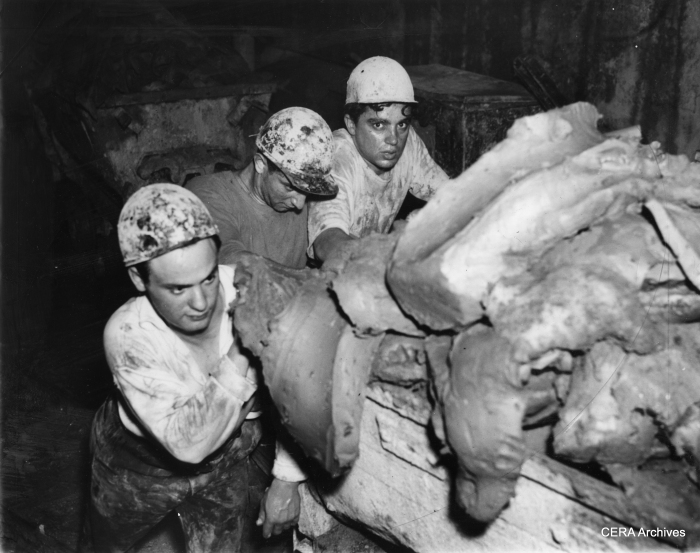
May 31, 1939 – “Muckers” push a load of blue clay after stripping it from the walls of Chicago’s future subway.
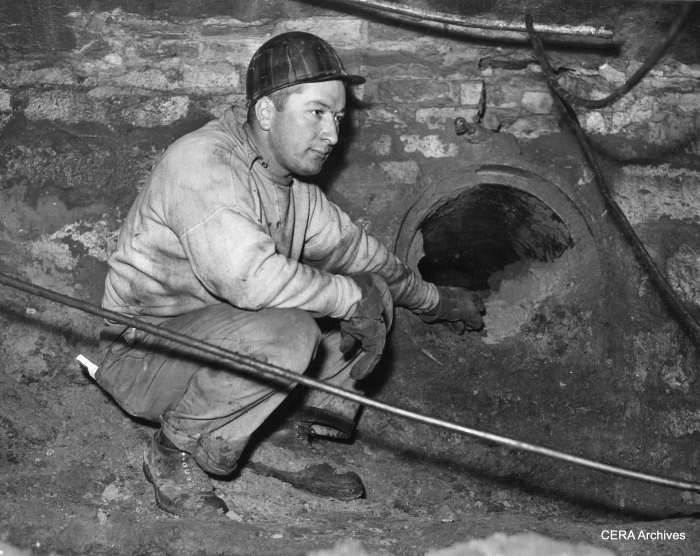
February 1, 1940 – “Mike Sunta, 4044 Montgomery, subway worker looking at the old tube where the street car cables traveled through.” (More likely, these were tubes related to the cable car system that preceded streetcars.)

February 18, 1941 – The State Street Council on inspection tour of the Chicago subway. They are shown in the observation car they rode through the subway in.

Models in furs pose in the uncompleted subway station at Clark and Division on March 18, 1943. Note the bare wires coming out of the ceiling.
Valarie Losinicki, 18, 10517 Oglesby and Eva Frendreis, 21, 1936 Wellington are shown coming up the escalator. Two ticket cages and their turnstyles are shown in the background.
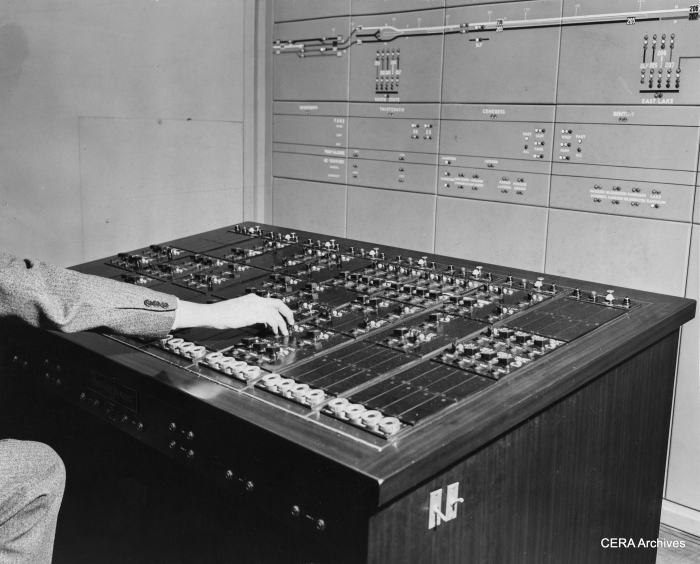
October 12, 1943 – “Power control panel that has complete control over all electric power of the Subway, and small sections of the power can be cut off or the entire section, depending on occasion. This is located on the 12th floor of the Commonwealth building.”
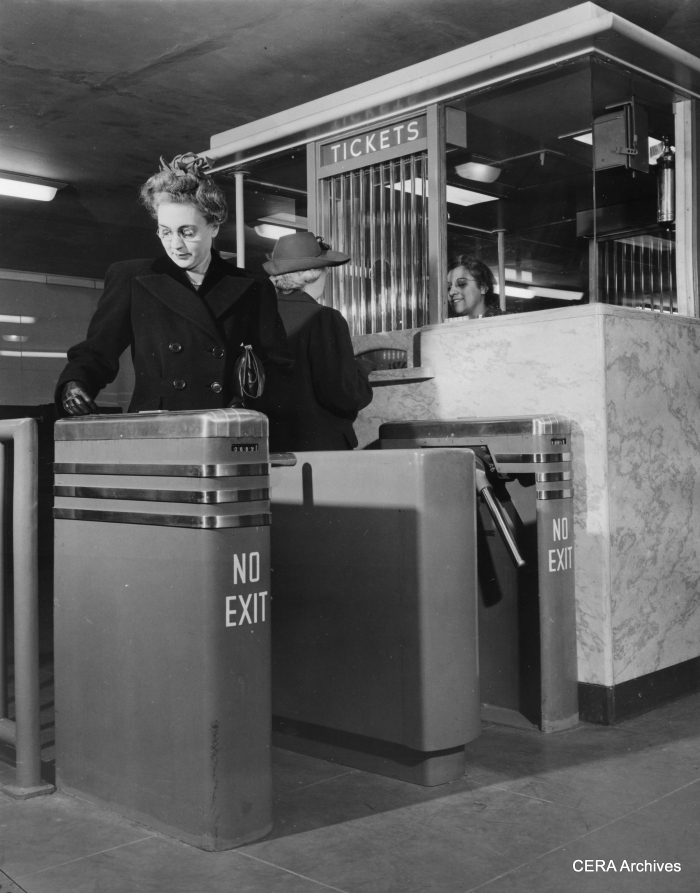
October 21, 1943 – “The stile at left operates with a dime, while the ticket seller turns the one at the right from her booth for passengers using transfers or those requiring change.”
AT LAST – THE CHICAGO SUBWAY
The Chicago Subway is a joke no longer. After wrestling with its traction problem for more than 75 years, the city has finally completed the 4.9 miles of the first section of the underground tube, now serving North and South Side residents. Started on December 20, 1938, the beginning of the system was dedicated on October 16, by Mayor Edward Kelly. So far, the cost is nearly $57,200,00, a figure expected to reach approximately $217,000,000 upon completion of the 18th underground city transit system in the world.

A Chicago subway scene on December 23, 1943. “Escalator all to himself, post-midnight customer reads while he rides. No din, no shove.”
In 1938, when the FDR Administration (via Harold Ickes and the PWA) approved plans for Chicago’s “Initial System of Subways,” it seemed baffling to many, that the east-west streetcar subways were nixed, while a subway on Dearborn was approved that appeared to simply end at Congress street and connect to nothing on the south end. However, I have uncovered documentary evidence that this second subway was always intended to connect to a “subway” median line in the Congress Super-Highway, which at that time had not yet been approved. So rather than play up this incongruity, press reports of the day tended to remain silent on the matter.
However, on page 5 of the November 1938 issue of Surface Service, the CSL’s employee publication, it says:
Subway Extensions
The City must on or before July 1, 1939, or such later date as the Administrator may approve, submit a comprehensive plan for extension of the subway system satisfactory to the Administrator and in such detail as he may require, to include provisions for the widening of Congress street from Michigan avenue westward and for the construction of a subway in west Congress street from Dearborn street westward.
In the event that the State of Illinois makes available for such construction the proceeds of the motor fuel tax or other monies adequate for this purpose, the City must proceed promptly with this construction and carry it on as rapidly as possible according to the approved plan.
You can read the entire article here.
This in fact is what did happen. In 1939, the City made public their plans for “phase 2″ of subway extensions, which included connecting up the Milwaukee-Dearborn subway to a relocated Garfield Park line in the median of the Congress Super-Highway. At first, it was not clear whether the entire Garfield “L” would be relocated, or only the portion in the expressway “footprint.” This was the general area between Sacramento and Halsted, where Garfield Park trains (but not the CA&E, who refused to participate) were rerouted via surface trackage on Van Buren street.
The PWA also insisted that Chicago follow through on unifying the surface and rapid transit systems, then run by CSL and CRT, private companies that were in bankruptcy. This was considered essential to obtaining the new all-steel subway cars that were needed to operate the two subways.
The government allowed the State Street subway to be completed during the war as a matter of necessity, using the 455 steel cars that the Chicago Rapid Transit company had. But once war broke out and there were delays in merging CSL and CRT into a new private entity (which perhaps would have been called the CTC, or Chicago Transit Company), work on the Dearborn-Milwaukee tube was halted in 1942 “for the duration.” At this point, it was estimated that the second subway was 75-80% completed.
World War II also halted work on the Congress expressway. Work on both the subway and the superhighway resumed in 1945. Chicago finally achieved transit unification in 1945 with the creation of the Chicago Transit Authority by state statute.
In 1944, the City had looked into the idea of purchasing 65 articulated rapid transit cars itself (the equivalent of 130 single cars), and would presumably have leased them to CRT for use in the Dearborn subway, if not for the creation of the CTA. As it happened, the fledgling CTA had CRT order four articulated trainsets, which were delivered in 1947-48 and numbered 5001-5004. Presumably, these were all that the broke CRT could afford.
CTA also stage-managed CSL’s order of 600 postwar PCCs in a similar manner. The Surface Lines had millions of dollars set aside for purchasing new equipment, and was in much better financial shape than CRT, who could barely make operating expenses. Starting in 1939, the City had been publicizing a “wish list” for modernizing the surface and rapid transit systems, and wanted to get a quick start on buying new equipment, even before the CTA took over CSL and CRT in 1947.
In 1949, CTA ordered 130 6000-series PCC rapid transit cars without articulation. Delivery began in 1950, which permitted the opening of the Dearbon subway in February, 1951. Connecting the Dearborn subway to the Congress median portion did not happen until 1958, and even then, some of the outer stations on the line were not finished until 1961.
The “phase 2″ subway extension plans came up again in the mid-1950s, when plans started to extend the Logan Square “L” in the median of the Northwest (now Kennedy) expressway. A leading neighborhood activist group preferred that the Milwaukee subway simply be extended to the city limits as a subway, claiming that the City had promised the Federal government in 1939 to do this and thus had a legal obligation.
They felt that the expressway median was not the best place for a rapid transit line, as it would be too far away from people in the surrounding neighborhoods. In particular, they felt that the area along Kimball needed improved rapid transit service.
Once Federal money for mass transit became available in the mid-1960s, a compromise was reached with the mile-long Kimball subway. The original connection to the NW median would have been east of there, near California avenue. The City’s 1950s plan called for a ramp to veer off northward from the “L” at this point, going down into an open cut subway, which would have gone into the expressway median. There would have been one new grade crossing required in this plan.
The new plan, while more expensive, was clearly an improvement, as it allowed for service to continue to Logan Square, which the old plan bypassed. So even the Kimball subway owes its origins in part to Chicago’s 1930s plans for its “Initial System of Subways.”
-David Sadowski
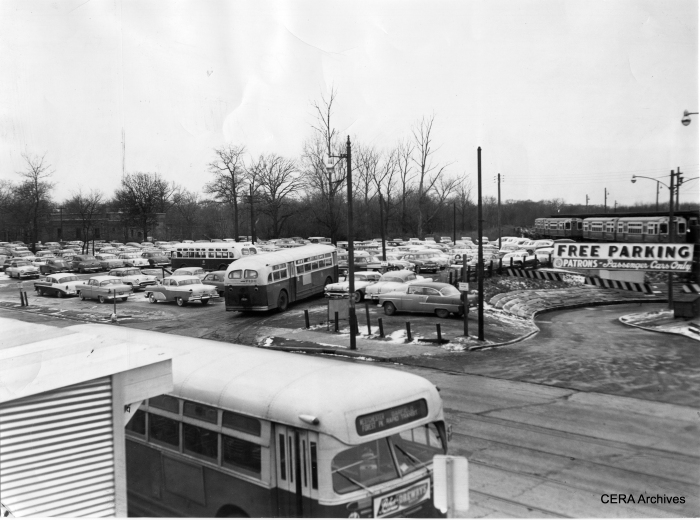
The south end of the parking area at Des Plaines in Forest Park on December 10, 1957, about five months after CA&E suspended passenger service. Note the #17 bus, which replaced the Westchester branch of the “L” in 1951.
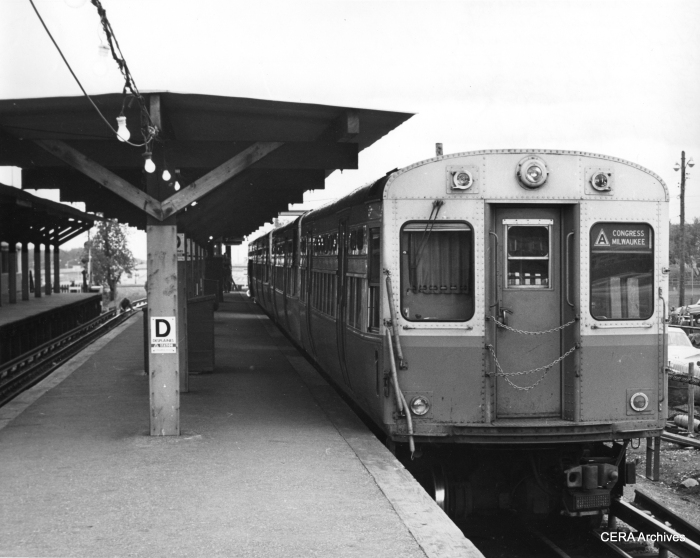
A four-car Congress-Milwaukee A train at the Des Plaines station in Forest Park on May 26, 1961. (Photo by Lawrence H. Boehning)